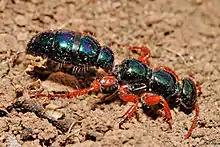| Blue ant | |
|---|---|
 | |
| Female | |
| Scientific classification | |
| Domain: | Eukaryota |
| Kingdom: | Animalia |
| Phylum: | Arthropoda |
| Class: | Insecta |
| Order: | Hymenoptera |
| Family: | Thynnidae |
| Subfamily: | Diamminae |
| Genus: | Diamma |
| Species: | D. bicolor |
| Binomial name | |
| Diamma bicolor Westwood, 1835 | |
The blue ant (Diamma bicolor), also known as the blue-ant or bluebottle, is a species of flower wasp in the family Thynnidae.[1] It is the sole member of the genus Diamma and of the subfamily Diamminae. Despite its common name and wingless body, it is not an ant but rather a species of large, solitary, parasitic wasp.[2]
Distribution
The blue ant is endemic to south and southeast Australia, including the states of Tasmania, New South Wales, Victoria, and South Australia.
Description and identification
Blue ants have a distinctive metallic blue-green body, with red legs. The female ranges up to 25 mm (1 in) in length, and is wingless. The male is smaller, about 15 mm (5⁄8 in), and has wings.
Biology
Blue ants are ground-nesting. They are unusual among members of the family Thynnidae in exclusively hunting mole crickets as larval provisions, whereas all other species of thynnids attack beetle larvae. The cricket is paralysed with venom injected by the female's stinger and an egg is laid upon it so the wasp larva has a ready supply of food.[3]
Adults feed on nectar and pollinate various native Australian flowers.
They are fast-moving and burrow under leaves to escape danger. They do not show aggression unless provoked.
Gallery
 Blue ant female
Blue ant female Blue ant female with damaged antennae
Blue ant female with damaged antennae.jpg.webp) Blue ant male
Blue ant male
References
- ↑ Pilgrim, E.; von Dohlen, C.; Pitts, J. (2008). "Molecular phylogenetics of Vespoidea indicate paraphyly of the superfamily and novel relationships of its component families and subfamilies". Zoologica Scripta. 37 (5): 539–560. doi:10.1111/j.1463-6409.2008.00340.x. S2CID 85905070.
- ↑ Farrow, Roger (May 2016). Insects of South-Eastern Australia: An Ecological and Behavioural Guide. Csiro Publishing. p. 30. ISBN 978-1-4863-0475-2.
- ↑ Gleeson, Michelle (2016). Miniature Lives: Identifying Insects in Your Home and Garden. Csiro Publishing. p. 130. ISBN 978-1-4863-0138-6.
External links
- Blue-ant Fact File (from the Australian Museum)
- Flower wasps (from the Australian Museum)
- Common names (and image) (from CSIRO Entomology)